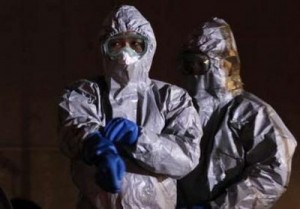The World Health Organization (WHO) declared COVID-19, also known as the new coronavirus, to be a pandemic on March 11. 
The virus has killed thousands of people worldwide, with over 135,000 confirmed cases and over 5,000 deaths. Public reaction has been mixed — many people have been rushing to grocery stores to stock up for a potential quarantine, while others have called the responses to be an overreaction.
According to Dr. Marty Makary, a medical professor at Johns Hopkins University, the coronavirus is something that “people need to take seriously.”
“I’m concerned when I hear a neighbor or a friend say that they’re planning to go to a kid’s swim meet in three weeks or going on vacation next week,” Makary said on Yahoo Finance’s “On the Move” (video above) on Friday. “No — we’re about to experience the worst public health epidemic since polio.”
‘Don’t believe the numbers you see’
In the U.S. there are over 1,600 confirmed cases, according to the Centers for Disease Control and Prevention (CDC), with 41 deaths. Makary said that the number of cases, though, is likely much higher.
“Don’t believe the numbers when you see, even on our Johns Hopkins website, that 1,600 Americans have the virus,” he said. “No, that means 1,600 got the test, tested positive. There are probably 25 to 50 people who have the virus for every one person who is confirmed.”
He added: “I think we have between 50,000 and half a million cases right now walking around in the United States.”
Part of the reason the number of cases might be higher without people realizing it is because of the shortage of coronavirus testing kits from the CDC. Between Jan. 18 and March 12, there were 13,624 tests for COVID-19 conducted in the U.S. Meanwhile, South Korea has conducted over 100,000 tests, and the U.K. has tested nearly 25,000 people.

“The CDC did admit to a mistake in the rollout of the testing and let’s face it — they went with the wrong testing system,” Makary said. “It was an early decision. It lived deep within the CDC and they have acknowledged that mistake.”
Despite issues with having enough testing kits for coronavirus, Makary said this didn’t change how he and other health professionals have been treating their patients.
“If we see you with coronavirus, we treat you the same regardless of that test result,” he said. “If it’s influenza or coronavirus, we give you respiratory support when it is needed. We recommend the same precautions. It’s helpful to mitigate the spread but that’s where the testing situation stands now.”
‘We could see 200,000 new patients … up to 2 million’
There are other ways to slow down the contagion that don’t involve a medical background, like regularly washing your hands, avoiding touching your face, and practicing social distancing. This can help ease the burden on health care workers and try to prevent hospitals from being overwhelmed with patients.
“Our American hospitals have had very little room to take on increased capacity,” Makary said. “Most ICUs function at full capacity or near full capacity. We only have 100,000 ICU beds in the United States. We could see 200,000 new patients that need critical care up to 2 million.”

In Italy, some hospitals in the northern region, which has been hit the hardest in the country by coronavirus, are on the verge of running out of beds. According to the Washington Post, the hospitals have been able to manage so far “by delaying surgeries, stopping HIV treatments, converting regular hospital space into COVID-19 units, and depending on exhausted doctors and nurses — some of whom are becoming sick themselves.”
“We’re watching what’s happening in Italy very closely,” Makary said. “China was not transparent. Iran was not transparent. But Italy has been extremely transparent, and what we’re seeing there is a hospital system that’s entirely overrun, even with the quarantine, which we have not done. So I think we need to prepare for the worst and hope for the best.”
That means stopping nonessential activities and travel for as long as needed to contain the spread of the virus, he said, along with working from home.
“Look, we’ve got to abandon this idea that this virus is contained,” Makary said. “It is at large, and assume it’s on every door handle and on every car door and with every handshake.”









